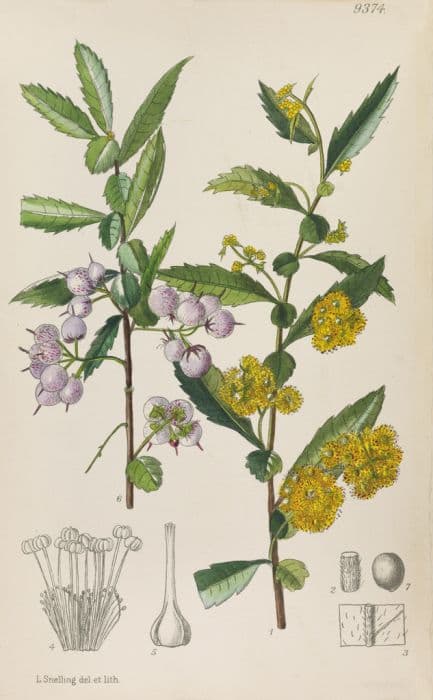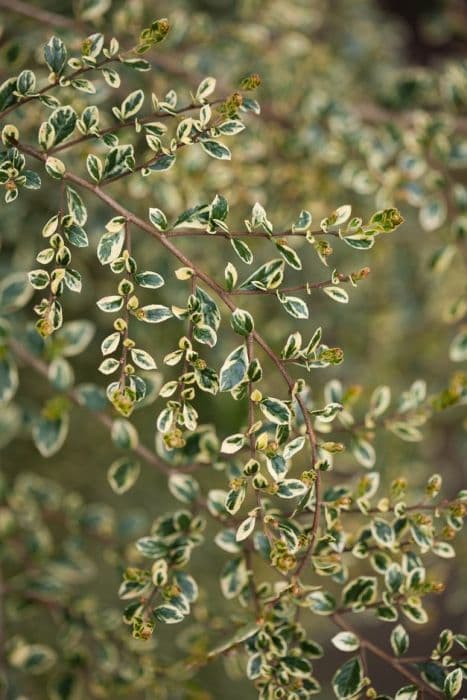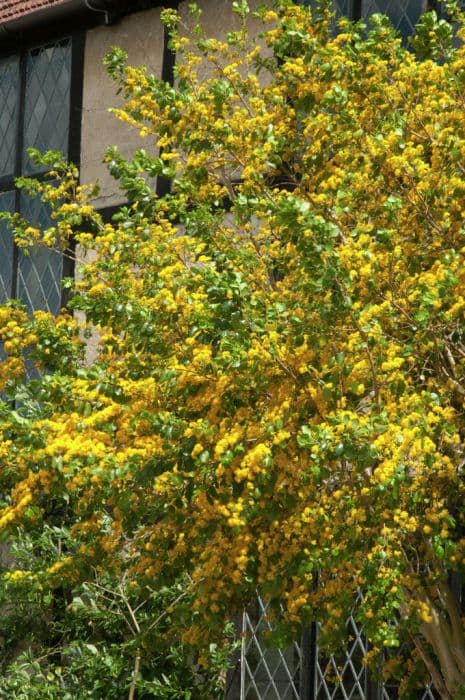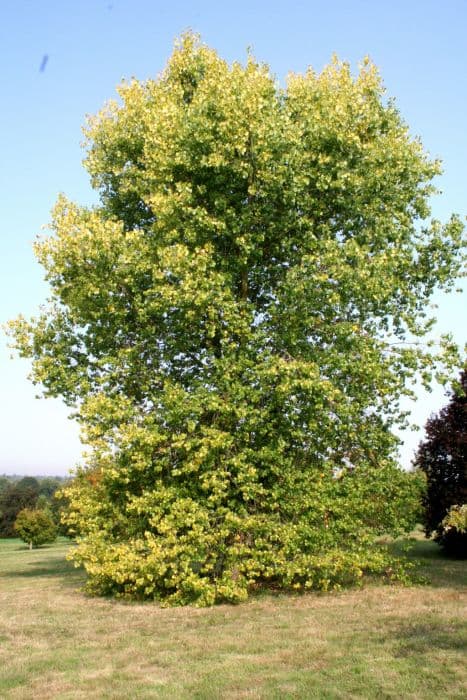Wehrhahn's Willow Salix hastata 'Wehrhahnii' (m)

ABOUT
The plant in question, commonly known as the Wehrhahn willow, is a deciduous shrub recognized for its distinctive foliage and catkins. The leaves of this plant typically have a blue-green hue and exhibit a lance-shaped, narrow profile with a slightly wrinkled texture, creating a somewhat silverfish appearance due to the fine hairs covering them. During the blooming period, the Wehrhahn willow produces catkins, which are fluffy, elongated clusters of flowers. These catkins emerge before the leaves fully develop and are often silvery when young but gradually turn yellow as the male flowers mature, adding a touch of color to the plant. The plant's overall form is upright and bushy, with multiple stems that create a rounded and dense appearance. The bark on the young branches can be smooth and showcase varying shades of brown or gray. It should be noted that this plant is primarily known for its ornamental value in the garden, thanks to the textural contrast its foliage and catkins provide against other plants. Overall, the Wehrhahn willow is a striking shrub, with its visual appeal stemming from both the color and texture of its leaves and flowers.
About this plant
 Names
NamesFamily
Salicaceae
Synonyms
Wehrhahn's Willow
Common names
Salix hastata 'Wehrhahnii'
 Toxicity
ToxicityTo humans
Salix hastata 'Wehrhahnii', commonly known as Halberd Willow, is generally not considered toxic to humans. There are no well-documented cases of poisoning from this plant, and it is typically not associated with any particular toxicity for people. However, like many plants, it could potentially cause irritation or an allergic reaction in sensitive individuals if parts of the plant are ingested or come into contact with skin. In general, it is always advisable to exercise caution and avoid ingesting parts of ornamental plants due to variability in individual reactions and the potential presence of unknown compounds.
To pets
Halberd Willow, the common name of Salix hastata 'Wehrhahnii', is not commonly known to be toxic to pets. Willows in general, including the Halberd Willow, contain salicin, a compound that is the basis for aspirin. While not highly toxic, ingestion in significant quantities could potentially cause gastrointestinal upset or more serious symptoms in some pets, particularly in cats or dogs with certain health conditions. Symptoms may include vomiting, diarrhea, or signs of salicylate toxicity such as lethargy or abnormal behavior. It is always prudent to prevent pets from eating ornamental plants and to consult a veterinarian if you suspect your pet has ingested plant material that might be harmful.
 Characteristics
CharacteristicsLife cycle
Perennials
Foliage type
Deciduous
Color of leaves
Green
Height
4-5 feet (1.2-1.5 meters)
Spread
4-6 feet (1.2-1.8 meters)
Plant type
Shrub
Hardiness zones
4
Native area
Europe
Benefits
 General Benefits
General Benefits- Attracts Wildlife: Salix hastata 'Wehrhahnii' is known for attracting bees, butterflies, and other beneficial insects to the garden.
- Ornamental Value: This plant features attractive silvery catkins that add textural and visual interest to landscapes.
- Erosion Control: Its root system can stabilize soil and help prevent erosion on slopes and banks.
- Windbreak: Can be used as a windbreak or screen due to its dense growth habit.
- Low Maintenance: Salix hastata 'Wehrhahnii' is generally low maintenance, requiring minimal care once established.
- Adaptable: It is adaptable to a variety of soil conditions and can tolerate wet ground, making it useful for challenging planting sites.
- Seasonal Interest: Provides seasonal interest with changing foliage and catkins, maintaining visual interest throughout different seasons.
- Wildlife Habitat: Offers habitat and nesting sites for birds in a naturalized or wildlife-friendly garden setting.
- Fast Growth: It has a fast growth rate, which can quickly provide coverage or fill in garden spaces.
- Pollution Tolerant: Salix hastata 'Wehrhahnii' is capable of withstanding urban pollution, making it suitable for urban or roadside plantings.
 Medical Properties
Medical PropertiesThis plant is not used for medical purposes.
 Air-purifying Qualities
Air-purifying QualitiesThis plant is not specifically known for air purifying qualities.
 Other Uses
Other Uses- Willow Hedge Creation: 'Wehrhahnii' is ideal for forming dense, low hedges in garden landscapes, providing structured yet natural borders.
- Wildlife Habitat: The dense foliage and twigs provide shelter and nesting sites for small birds and insects.
- Living Structures: Flexible young stems can be woven to create living arbors, tunnels, or other garden structures that leaf out seasonally.
- Stream Bank Stabilization: The robust root system helps prevent soil erosion along waterways and can be used in restoration projects.
- Craft Material: The stems can be harvested and used in basketry and other traditional crafts due to their flexibility and strength.
- Fodder for Livestock: In some regions, the leaves can serve as an emergency fodder source for livestock, particularly goats.
- Dye Production: The bark contains tannins that can be used to produce natural dyes for fabrics or leather.
- Winter Interest: The catkins (male flower clusters) provide visual interest in the garden during the late winter months.
- Green Woodworking: Freshly cut stems may be used in green woodworking projects due to their ease of shaping and bending.
- Photography Subject: The unique form and texture of the willow provide interesting subjects for photographers, particularly in winter landscapes.
Interesting Facts
 Feng Shui
Feng ShuiThe Salix hastata, commonly known as the Halberd Willow, is not specifically used in Feng Shui practice.
 Zodiac Sign Compitability
Zodiac Sign CompitabilityThe Halberd Willow is not used in astrology practice.
 Plant Symbolism
Plant Symbolism- Flexibility: Salix hastata 'Wehrhahnii', commonly known as Wehrhahnii Willow, possesses flexible branches, which have come to symbolize adaptability and resilience in the face of challenges.
- Growth and Renewal: Willows are known for their vigorous growth and ability to regenerate even from a broken twig, representing the themes of personal growth, renewal, and the cycle of life.
- Grief and Mourning: Willows have long been associated with sorrow and mourning, partly due to their drooping branches that can appear to weep, offering a symbol of empathy and solace in times of loss.
- Protection: In folklore, willows were often thought to possess protective qualities, with the practice of planting a willow near one's home believed to ward off evil spirits and misfortune.
- Healing: Historically, the willow's bark, which contains salicin (a precursor to aspirin), has been used for medicinal purposes, symbolizing healing and the alleviation of pain.
- Freedom: The willow's affinity for water and the way it sways with the breeze gives it a connotation of freedom and the ability to let go of past attachments to move forward unencumbered.
- Love and Friendship: The weeping nature of willows can also represent deep emotional connections and the boundless nature of love and friendship.
 Water
WaterThe Salix hastata 'Wehrhahnii', commonly known as Wehrhahn's Willow, prefers consistently moist soil and should be watered deeply once a week, allowing for slight soil drying between waterings. During hot or dry weather, watering frequency should increase to twice a week, with each watering providing enough water to soak the ground at the base of the plant, which may equate to about 2-3 gallons depending on the size and established nature of the shrub. In winter, reduce the amount of water to match the plant's decreased growth rate and evapotranspiration needs.
 Light
LightWehrhahn's Willow thrives best in full sun to partial shade. It should be placed in a spot where it can receive at least 6 hours of direct sunlight each day, but it can also tolerate some light afternoon shade. The ideal location would provide morning sunlight and shelter from the intense late afternoon sun, if conditions are particularly hot.
 Temperature
TemperatureWehrhahn's Willow is hardy and can withstand a range of temperatures. The plant can survive in temperatures as low as -30°F and as high as 100°F, although it thrives best in temperatures between 50°F and 75°F. It is important to protect the plant from extreme cold by providing mulch around the base, especially in the first few years after planting.
 Pruning
PruningPruning Wehrhahn's Willow helps maintain its shape and remove dead or diseased branches, encouraging healthy growth. It's best to prune in late winter or early spring before new growth begins. Once a year, selectively thin out the older stems and cut back any overgrown branches to maintain the desired size and structure. Pruning immediately after flowering allows the plant to set buds for the next season.
 Cleaning
CleaningAs needed
 Soil
SoilHalberd Willow requires moist, well-draining soil with a pH range of 6.0 to 7.5. A mixture of loam, peat, and sand is ideal to maintain the proper moisture and stability for the roots. Adding organic matter can enhance soil fertility and structure, supporting vigorous growth.
 Repotting
RepottingHalberd Willow, being a larger shrub, doesn't require frequent repotting and is often planted directly in the ground. If grown in a container, repotting every 2-3 years or when rootbound is sufficient.
 Humidity & Misting
Humidity & MistingHalberd Willow thrives best in moderate to high humidity environments, mimicking its natural wetland habitat. Ensuring a humidity level of around 50-70% would be optimal for the plant's health.
 Suitable locations
Suitable locationsIndoor
Place Halberd Willow in bright, indirect light and keep soil moist.
Outdoor
Plant Halberd Willow in full sun to partial shade; water regularly.
Hardiness zone
4-8 USDA
 Life cycle
Life cycleThe life cycle of Salix hastata 'Wehrhahnii', commonly known as Wehrhahn's Willow, starts with seed germination in suitable moist conditions, often near water bodies. The seeds grow into juvenile plants, which rapidly develop a root system and shoots with characteristic lanceolate leaves. As the plant matures, it enters the vegetative stage, producing dense foliage and elongating its stems. Following this, Wehrhahn's Willow reaches reproductive maturity, forming catkins that are either male or female, as it is a dioecious species. After pollination, typically by wind or insects, female catkins will develop into capsules that release seeds, completing the reproductive cycle. Finally, the plant may continue this cycle for several years while reaching the senescence stage, where growth slows and the plant may eventually die, although willows are known for their resilience and ability to propagate vegetatively through cuttings or layering.
 Propogation
PropogationPropogation time
Spring-Early Summer
The most popular method of propagating Salix hastata 'Wehrhahnii', commonly known as Wehrhahn's willow, is through cuttings. This technique is typically performed in late winter or early spring, just before the new growth begins. To propagate, one should select healthy, young branches and trim cuttings about 6-9 inches (15-23 cm) long, ensuring at least two or more sets of buds are present. The lower end of the cutting is dipped in rooting hormone to encourage root development and then planted in well-draining soil, keeping the soil consistently moist until roots establish. Placing the cuttings in a sheltered location out of direct sunlight can help improve the chances of successful rooting.









